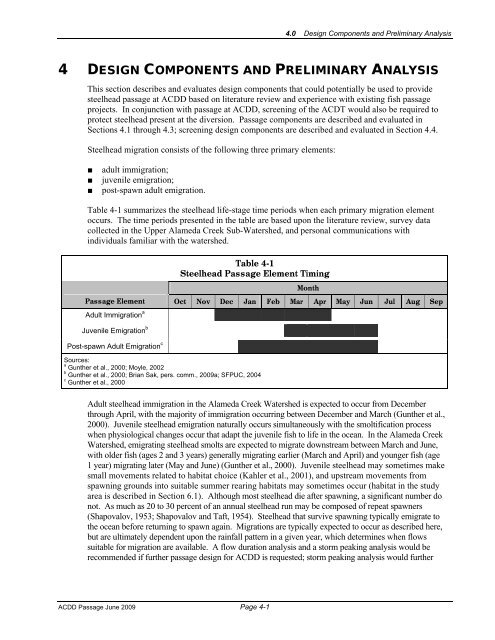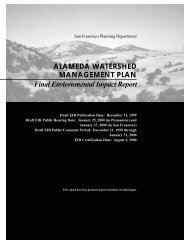Feasibility of Fish Passage at Alameda Creek Diversion Dam
Feasibility of Fish Passage at Alameda Creek Diversion Dam
Feasibility of Fish Passage at Alameda Creek Diversion Dam
Create successful ePaper yourself
Turn your PDF publications into a flip-book with our unique Google optimized e-Paper software.
4.0 Design Components and Preliminary Analysis4 DESIGN COMPONENTS AND PRELIMINARY ANALYSISThis section describes and evalu<strong>at</strong>es design components th<strong>at</strong> could potentially be used to providesteelhead passage <strong>at</strong> ACDD based on liter<strong>at</strong>ure review and experience with existing fish passageprojects. In conjunction with passage <strong>at</strong> ACDD, screening <strong>of</strong> the ACDT would also be required toprotect steelhead present <strong>at</strong> the diversion. <strong>Passage</strong> components are described and evalu<strong>at</strong>ed inSections 4.1 through 4.3; screening design components are described and evalu<strong>at</strong>ed in Section 4.4.Steelhead migr<strong>at</strong>ion consists <strong>of</strong> the following three primary elements:■■■adult immigr<strong>at</strong>ion;juvenile emigr<strong>at</strong>ion;post-spawn adult emigr<strong>at</strong>ion.Table 4-1 summarizes the steelhead life-stage time periods when each primary migr<strong>at</strong>ion elementoccurs. The time periods presented in the table are based upon the liter<strong>at</strong>ure review, survey d<strong>at</strong>acollected in the Upper <strong>Alameda</strong> <strong>Creek</strong> Sub-W<strong>at</strong>ershed, and personal communic<strong>at</strong>ions withindividuals familiar with the w<strong>at</strong>ershed.Table 4-1Steelhead <strong>Passage</strong> Element TimingMonth<strong>Passage</strong> Element Oct Nov Dec Jan Feb Mar Apr May Jun Jul Aug SepAdult Immigr<strong>at</strong>ion aJuvenile Emigr<strong>at</strong>ion bPost-spawn Adult Emigr<strong>at</strong>ion cSources:aGunther et al., 2000; Moyle, 2002bGunther et al., 2000; Brian Sak, pers. comm., 2009a; SFPUC, 2004cGunther et al., 2000Adult steelhead immigr<strong>at</strong>ion in the <strong>Alameda</strong> <strong>Creek</strong> W<strong>at</strong>ershed is expected to occur from Decemberthrough April, with the majority <strong>of</strong> immigr<strong>at</strong>ion occurring between December and March (Gunther et al.,2000). Juvenile steelhead emigr<strong>at</strong>ion n<strong>at</strong>urally occurs simultaneously with the smoltific<strong>at</strong>ion processwhen physiological changes occur th<strong>at</strong> adapt the juvenile fish to life in the ocean. In the <strong>Alameda</strong> <strong>Creek</strong>W<strong>at</strong>ershed, emigr<strong>at</strong>ing steelhead smolts are expected to migr<strong>at</strong>e downstream between March and June,with older fish (ages 2 and 3 years) generally migr<strong>at</strong>ing earlier (March and April) and younger fish (age1 year) migr<strong>at</strong>ing l<strong>at</strong>er (May and June) (Gunther et al., 2000). Juvenile steelhead may sometimes makesmall movements rel<strong>at</strong>ed to habit<strong>at</strong> choice (Kahler et al., 2001), and upstream movements fromspawning grounds into suitable summer rearing habit<strong>at</strong>s may sometimes occur (habit<strong>at</strong> in the studyarea is described in Section 6.1). Although most steelhead die after spawning, a significant number donot. As much as 20 to 30 percent <strong>of</strong> an annual steelhead run may be composed <strong>of</strong> repe<strong>at</strong> spawners(Shapovalov, 1953; Shapovalov and Taft, 1954). Steelhead th<strong>at</strong> survive spawning typically emigr<strong>at</strong>e tothe ocean before returning to spawn again. Migr<strong>at</strong>ions are typically expected to occur as described here,but are ultim<strong>at</strong>ely dependent upon the rainfall p<strong>at</strong>tern in a given year, which determines when flowssuitable for migr<strong>at</strong>ion are available. A flow dur<strong>at</strong>ion analysis and a storm peaking analysis would berecommended if further passage design for ACDD is requested; storm peaking analysis would furtherACDD <strong>Passage</strong> June 2009 Page 4-1








